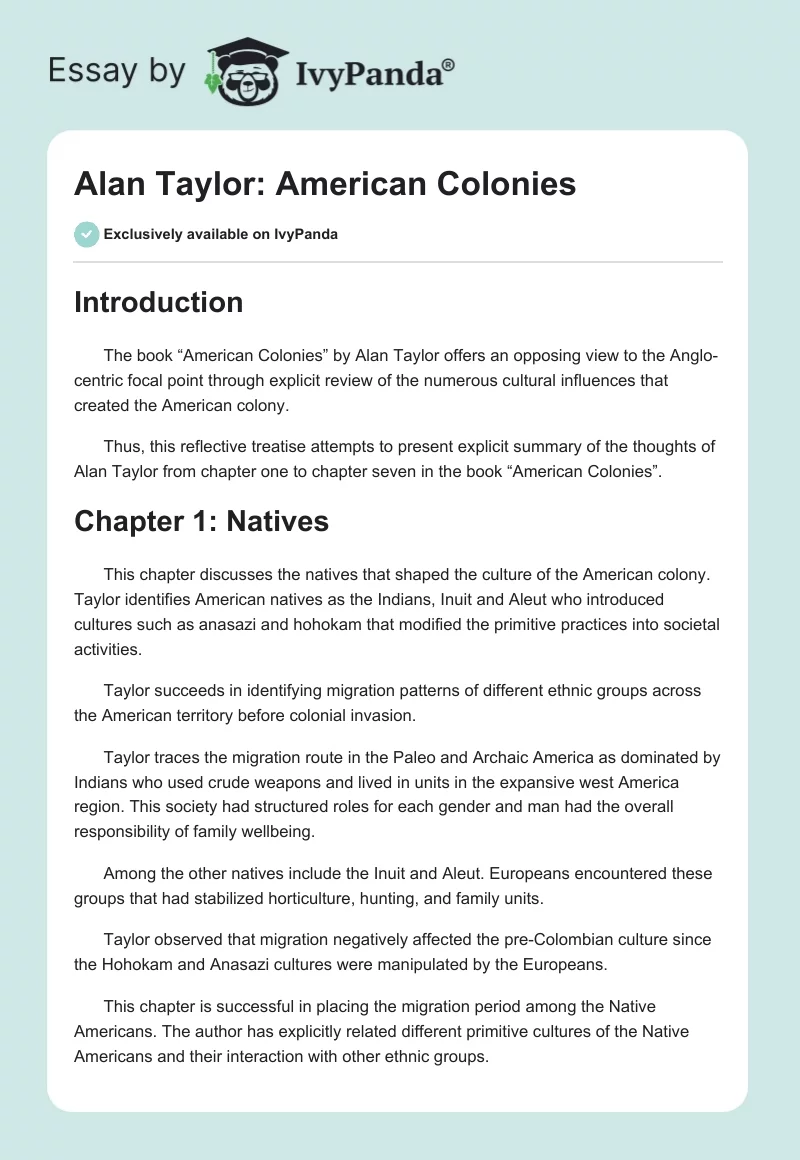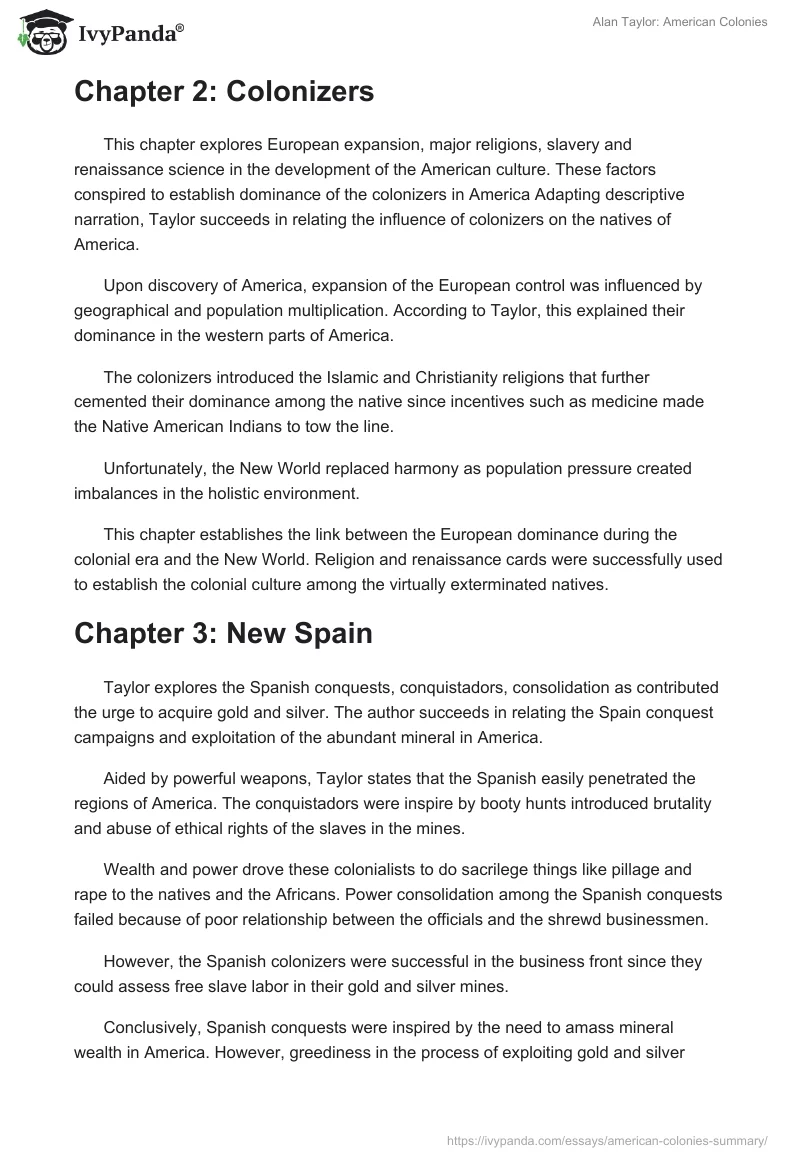Introduction
The book “American Colonies” by Alan Taylor offers an opposing view to the Anglo-centric focal point through explicit review of the numerous cultural influences that created the American colony.
Thus, this reflective treatise attempts to present explicit summary of the thoughts of Alan Taylor from chapter one to chapter seven in the book “American Colonies”.
Chapter 1: Natives
This chapter discusses the natives that shaped the culture of the American colony. Taylor identifies American natives as the Indians, Inuit and Aleut who introduced cultures such as anasazi and hohokam that modified the primitive practices into societal activities.
Taylor succeeds in identifying migration patterns of different ethnic groups across the American territory before colonial invasion.
Taylor traces the migration route in the Paleo and Archaic America as dominated by Indians who used crude weapons and lived in units in the expansive west America region. This society had structured roles for each gender and man had the overall responsibility of family wellbeing.
Among the other natives include the Inuit and Aleut. Europeans encountered these groups that had stabilized horticulture, hunting, and family units.
Taylor observed that migration negatively affected the pre-Colombian culture since the Hohokam and Anasazi cultures were manipulated by the Europeans.
This chapter is successful in placing the migration period among the Native Americans. The author has explicitly related different primitive cultures of the Native Americans and their interaction with other ethnic groups.
Chapter 2: Colonizers
This chapter explores European expansion, major religions, slavery and renaissance science in the development of the American culture. These factors conspired to establish dominance of the colonizers in America Adapting descriptive narration, Taylor succeeds in relating the influence of colonizers on the natives of America.
Upon discovery of America, expansion of the European control was influenced by geographical and population multiplication. According to Taylor, this explained their dominance in the western parts of America.
The colonizers introduced the Islamic and Christianity religions that further cemented their dominance among the native since incentives such as medicine made the Native American Indians to tow the line.
Unfortunately, the New World replaced harmony as population pressure created imbalances in the holistic environment.
This chapter establishes the link between the European dominance during the colonial era and the New World. Religion and renaissance cards were successfully used to establish the colonial culture among the virtually exterminated natives.
Chapter 3: New Spain
Taylor explores the Spanish conquests, conquistadors, consolidation as contributed the urge to acquire gold and silver. The author succeeds in relating the Spain conquest campaigns and exploitation of the abundant mineral in America.
Aided by powerful weapons, Taylor states that the Spanish easily penetrated the regions of America. The conquistadors were inspire by booty hunts introduced brutality and abuse of ethical rights of the slaves in the mines.
Wealth and power drove these colonialists to do sacrilege things like pillage and rape to the natives and the Africans. Power consolidation among the Spanish conquests failed because of poor relationship between the officials and the shrewd businessmen.
However, the Spanish colonizers were successful in the business front since they could assess free slave labor in their gold and silver mines.
Conclusively, Spanish conquests were inspired by the need to amass mineral wealth in America. However, greediness in the process of exploiting gold and silver deposits in America made the colonizers commit hideous crimes against the natives and the African slaves.
Chapter 4: The Spanish Frontier
This chapter explores the impacts of Spanish colonization of North America. Taylor identifies establishment of Christianity, revolts, and dominance of the colonizers.
The author is successful in relating the 1680 and 1696 revolts in Northern America against the Spanish to natives’ dissatisfactions of the religions and economic systems of colonizers.
The impacts of Spanish colonization of North America are explained by Taylor as dissolution and destruction of the native belief systems. The natives were subjected to brutality for resisting Christianity faith and provide free force labor to the Spanish colonizers.
Dissolution led to the 1680 and 1696 revolts since the Spanish religious systems, medicine, and culture did not provide solutions to the social problems experienced by the natives.
The poorly nourished Pueblo natives could not keep up with the demands for harsh labor and unrealistic tribute money demanded by colonial officials.
This chapter identifies overexploitation and unfairness as factors that led to revolt against the Spanish colonizers in Mexican cities. The 1680 and 1696 revolts that were won by the Spanish restored harmony between the Pueblos and colonizers since their concerns were addressed.
Chapter 5: Canada and Iroquoia
This chapter presents the differences in exploration and settlement between the Spanish and French. Taylor is succeeds in relating success of the French in American conquest to their peaceful and mutual trade relationship with the natives.
The Iroquoian and Algonquian cultures of the native Indians easily traded with the French in fur since they had mutual trade consent. The growing interest from both ends of the divide spurred this trade relationship.
This trade was protected from external interferences by the natives and the French. For instance, the Waging war executed by the Iroquois was to revenge the neighboring community use of sorcery to interfere with their fur trade.
The French were generally peaceful in their approach to interact with the Native Americans. The fur trade between the French and Iroquois was very successful because of the mutual respect.
Chapter 6: Virginia
Taylor identifies the need to expand dominance as factor which influenced British settlement in Virginia. The author is successful in linking the social, economic, and cultural elements of the natives in the establishment of Virginia.
Taylor describes the daring British folks such as Sir Francis Drake among others as the active English promotes who used tactical approaches to settle and establish Roanoke in Virginia.
The English are presented as the ungrateful barbarians who belie the values of the Native Indian Americans despite the warm reception and permission to cultivate tobacco in Virginia. War erupted between the two groups when the English started harassing the natives.
This chapter displays the ungratefulness and cunning nature of the British towards the natives of Virginia. Excessive harassment by the former spilled into war in Jamestown as native were determined to restore their lost culture.
Chapter 7: Chesapeake Colonies
Taylor explores the Chesapeake social class structure and how economics influenced its shape in the Chesapeake colonies.
The author is successful in establishing the basic elements of Chesapeake social class structure as determined by the ability to organize a commonwealth body controlled by common interests and laws.
Farming formed the primary labor source for colonists in Chesapeake. Settlers who were able to organize more factors of production occupied the apex of the hierarchal chain.
As competition increased, Taylor observed that slave labor contributed to population explosion of the African community in Chesapeake. This necessitated establishment of protectionist laws by the settlers to minimize possibility of African slaves’ revolt against their cruel masters.
This chapter explains operation of the commonwealth system in Chesapeake. Ability to organize factors of production determined the economic class of the settlers in Chesapeake.


